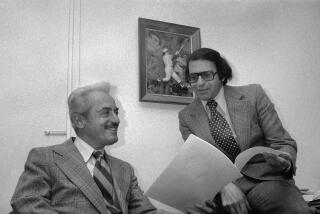THE NUMBERS GAMES : Will the Future Bring Collective Bargaining or Collective Discord?
In the next six months, sports fans are going to be treated to negotiations on new collective bargaining agreements for players from the National Football League and the National Basketball Assn. A year after that, itâll be time for baseballâs talks.
Not to preempt all the fascinating developments you were looking forward to, but there are some things all owners and players can be expected to agree on:
--Times are tough.
--Someone is making out like a bandit.
--Itâs not them.
They canât all be doing badly, though. Someoneâs deal must be better, which means, of course, that someoneâs deal is worse.
Have any of the leagues yet happened onto a system that works? One that might serve as the model for all future contracts and spare us all this public wrangling?
On the surface, the NBAâs seems to hold promise.
It offers a form of free agency that, on paper, guarantees players a free-market level of compensation, if not necessarily the last word on where they may play. Itâs called right of first refusal.
It also offers owners, on paper, a budget ceiling that allows them to bid against one another, but only up to a point. Itâs called the salary cap.
Under this plan, the NBA has gone from five to eight teams making money with four about to fold, to todayâs league in which 21 of the 23 teams are expected to show a profit. Those are the leagueâs figures. The playersâ calculations are, of course, a little more optimistic.
âWe think all 23 teams are doing fine,â said Charles Grantham, NBA Players Assn. executive vice president, from New York.
Under this contract, the average NBA salary has risen to $450,000. Thatâs the playersâ figure. The league calculations are, of course, a little more optimistic--$440,000 in salary plus $30,000 in benefits.
Everyone would seem to be prospering, but the players think the owners have been over-prospering. Theyâre threatening to try to overturn the draft. The league, of course, flatly rejects that idea.
How does the NBA deal stack up against footballâs and baseballâs? How do football and baseball stack up against each other?
NFL Average salary--$218,000 according to the league, $205,000 according to the players.
Percentage of gross revenue going to players--55%.
Ironically, though former union head Ed Garvey was derided for asking for a fixed wage scale, and was thought to have scrapped his request during the 1982 strike, the players came out with 55%, the highest percentage of the three leagues.
But since there are almost 70 players a team splitting that percentage--counting those on the active roster, those on injured reserve, those on and off the roster over a season--footballâs average salary pales in comparison to basketballâs and baseballâs.
Garvey may have wound up getting substantially what he asked, but the owners managed to save face while agreeing. And Garvey, increasingly embattled within his union, wound up leaving.
Said John Weistart, a Duke University law professor from Durham, N.C.: âWhile Garvey lost on his proposed wage scale, he did win a concession which seemed to be pretty good. It was in the form of a memorandum attached to the 1982 agreement, a letter from (Management Council head Jack) Donlan in which the owners guarantee to spend $1.28 billion a year on player salaries through 1986.
âThe fascinating thing is that itâs so crude. Management says, âWe arenât going for any crazy union scale. We just promise after all the dust settles that we will spend this much on playersâ costs. But we will control who it goes to and it wonât be paid out through your formula.â â
Whether this was an ownersâ declaration of intentions, or legally binding, is still being debated. The owners did, in fact spend most of what they promised to.
âYou could be just a little skeptical about the role of the union in that,â Weistart said. âSalaries went way up, but I have an impression they went way up because of the USFL. In effect, that document was mooted.â
If the average football salary rose dramatically during the USFL years, it is still far behind basketballâs and baseballâs and that isnât likely to change quickly. The USFL is gone.
The union announced that it will ask for unrestricted free agency in this contract and, in its pamphlet âGame Plan,â called it âour primary goal.â But when some of the members appeared to grow uneasy, NFLPA director Gene Upshaw began to emphasize that the list of demands was âhorizontalâ and not âvertical,â a suggestion that none of the unionâs eight demands was more important than any other.
Both players and owners seem to be showing the effects of the â82 strike and an air of conciliation has been evident in preliminary talks. Yet Weistart, asked which of the three leagues has the greatest potential for labor unrest over the long haul, suggests itâs the NFL.
He notes that NFL owners are enmeshed with each other in revenue sharing--they split the TV package equally and pay 40% of gate proceeds to the visiting team--which helps them maintain a unified, disciplined front. And theyâre adamantly opposed to free agency.
BASEBALL Average salary--$410,000, according to the ownersâ Player Relations Committee; âcloser to $350,000,â according to Roger Noll, the Stanford economics professor who audited the teamsâ books for the Major League Players Assn.
Percentage of gross revenues going to players--39.8% in 1984, according to Noll, down from a peak of 44.6% in 1982.
Baseball doesnât have to wait for the long-term, itâs already hip deep in discord.
The owners long held that a system with both free agency and salary arbitration is unfair. In the â81 strike, however, the players went seven weeks in defense of the system and hung onto it.
Last spring, however, the owners stopped bidding on free agents with their old ardor. The players filed a grievance on behalf of such free agents as Kirk Gibson and Donnie Moore, the case to be heard by arbitrator Tom Roberts.
Baseball withdrew its approval of Roberts after he overturned Commissioner Peter Ueberrothâs drug plan, and tried to have him taken down as the arbitrator in this case.
Another arbitrator ruled that Roberts must stay on in this case.
The players have filed another grievance this spring on behalf of free agents.
At the core of it all is the ownersâ new attitude. Are they just regaining their senses? Acting in collusion?
Says Noll: âPrior to the Ueberroth era, baseball operated like two leagues. In the Bowie Kuhn era, the two leagues rarely developed a joint policy about anything. They might have gentlemenâs agreements within leagues but the leagues were pretty competitive against each other. That really helped baseball players have meaningful free agency.
âUeberrothâs style is more like Pete Rozelleâs, to concentrate decision-making in the owners, rather than in the leagues.
âThe central issue, is this really collusion? I donât really know. . . . Iâm trying to say it in a neutral way. But the end result is that baseball will be more like football because of the way Ueberroth has organized things.â
Says Weistart: âI think baseball is a little more vulnerable. Thereâs obviously a rebound going on from the halcyon days of free agency. If thereâs one thing, in my experience, that sparks objections among a group of employees is any suggestion that they will retreat on an economic trail. Not going forward as fast as you were before is one thing but going backwards is a whole different kettle of fish.â
BASKETBALL Average salary--$450,000, playersâ figure; $470,000, NBAâs.
Percentage of gross revenue going to players--53%
The NBA has always lived closer to the edge of extinction than the two others and has been driven to more innovative thinking. If the current system looks promising, it still needs some--maybe a lot of--fine tuning.
Actually, one of the things that could be said of the salary cap/right-of-first-refusal tandem is that itâs barely been tried.
When NBA players signed the last contract, the players were convinced that four teams were on the verge of folding. Now that everyone knows the league is flush, Grantham says, âItâs business as usual.â
The players contend that the owners have all but stopped tendering offer sheets to free agents, that most of the salary gains were made in the first two years of the contract. Teams have found ways to finesse the salary cap.
Said Weistart: âThe players ought to feel lucky the salary cap was gutted. General managers are almost as creative, unquote, as lawyers.
âOne thing they could do was go above the salary cap to sign their own free agents. What happened almost immediately, you would sign all your veterans and then have your superstar declare himself a free agent. Then youâd knot your hands, express concern and say, âWell, weâve got to keep him. Weâve got to go above the salary cap.â Then youâd cut the veterans, in effect, freeing their salaries from the cap.
âI used to think that talking about abolishing the draft was the most preposterous thing Iâd ever heard of. I just had a conversation with Larry Fleischer (head of the playersâ union) and I think that with an effective salary cap, I could see it.
âWith the lottery and the trading of draft choices, itâs destroyed the value of the draft in replenishing weak teams, which is the only defense for having a draft. So what are the Celtics and the Sixers doing right up on top (as they were last spring)?â
Ironically, the NBA Players Assn. is the only one of the three unions that has never struck. It made its point early, when players threatened not to take the floor in the hours before the 1964 All-Star game in Boston.
Owners in football and baseball were convinced for years afterward that their star players would never walk, but basketball owners knew better.
More to Read
Go beyond the scoreboard
Get the latest on L.A.'s teams in the daily Sports Report newsletter.
You may occasionally receive promotional content from the Los Angeles Times.










